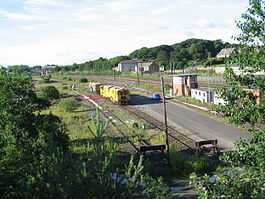Ferryhill railway station
| Ferryhill | |
|---|---|
|
Former site of Ferryhill station and goods yard, July 2007 | |
| Location | |
| Place | Ferryhill |
| Area | County Durham |
| Grid reference | NZ304319 |
| Operations | |
| Original company | Clarence Railway |
| Pre-grouping | North Eastern Railway |
| Post-grouping | London and North Eastern Railway |
| Platforms | 2 |
| History | |
| 16 January 1834 | Opened to freight |
| 1840 | Opened to passengers |
| October 1846 | Services start to Hartlepool |
| June 1887 | Rebuilt by NER as island platform |
| 6 March 1967 | Closes to passengers |
| 1967 | Closes to freight |
| 1969 | Burnt down, subsequently demolished |
| Disused railway stations in the United Kingdom | |
|
Closed railway stations in Britain A B C D–F G H–J K–L M–O P–R S T–V W–Z | |
| UK Railways portal | |
Ferryhill railway station was a railway station located in Ferryhill in County Durham, Northeast England. It was located on the East Coast Main Line between Darlington and Durham near the junctions with the branch line from Norton-On-Tees and the Leamside Line.
History
The Clarence Railway reached the village of Ferryhill on its Durham branch, opening for freight from Sedgefield and Stockton on 16 January 1834. The position was chosen as it lay close to both natural deposits of coal and limestone. On 3 July 1837, approval was given to develop a branch to Wingate for Durham, but only reached Cox Green. A second branch went west, eventually reaching Byers Green, which later was extended by the NER to Bishop Auckland.[1]
The first station was developed by the Clarence on the current site in 1840, serving a village population the of 850. The Clarence also developed a goods yard on the site, which latterly became one of the busiest in Europe between the 1920s and the 1950s. During World War II, the goods yard became the main alternative for all freight to York,[2] mainly due to volume of traffic but also occasional Nazi Luftwaffe bombing.
In 1844, the Newcastle and Darlington Junction Railway ran a line parallel to the Clarence south along the same route. After the Clarence was taken over by the Hartlepool Docks and Railway Company, they added a third branch east to Hartlepool, with services beginning in October 1846.[1]
After the two competing lines were amalgamated within the North Eastern Railway (NER), in June 1887 that railway company rebuilt the station as an island platform at a cost of £13,612. This was to allow the NER to make the station a stop for trains to and from Edinburgh to London Kings Cross. These services were continued when the station became part of the London and North Eastern Railway in 1923.[2]
To allow for better servicing of locomotives in the area, the NER built an adjacent engine shed in 1871, which as the coal mines in the area declined was closed from 1938.[2]
In 1902 Bolckow Vaughan sank the Dean and Chapter Colliery just south of the station, which until its closure in 1969 provided much of the station's traffic. The development included a coking coal works, which closed in 1930. In 1946 both Dean and Chapter and the local Mainsforth Colliery were nationalised and taken over by the National Coal Board.[2]
Closure
The branch lines serving the station had closed to passenger traffic by the early 1950s - the last to go being those to Middlesbrough via Stockton on 31 March 1952 and to Hartlepool on 9 June the same year. In 1963 as part of the Beeching Axe, it was recommended that the station close. However, strong local opposition resulted in the station remaining open for passengers until 6 March 1967.[3][4] It remained open as a goods-only station, but after the closure of Dean and Chapter in 1969, the station burnt down.[2] The demolition contractors for the colliery in the 1970s also demolished the residual station building structures.[2]
Present
Little remains of the former station in 2014, although freight trains still service the Lafarge cement works at Thrislington Quarry to the north, which is scheduled to be redeveloped as a landfill site.[5] The junction between the ECML and line to Stockton & Middlesbrough remains in use, though the latter route is only open for freight traffic and occasional diversions.
| Preceding station | |
Following station | ||
|---|---|---|---|---|
| Bradbury | London and North Eastern Railway East Coast Main Line |
Croxdale | ||
| Terminus | London and North Eastern Railway Leamside Line |
Shincliffe | ||
| Sedgefield | London and North Eastern Railway Clarence Railway |
Bradbury | ||
| Terminus | London and North Eastern Railway Clarence Railway (Byers Green Branch) |
Spennymoor | ||
References
- ↑ 1.0 1.1 "Clarence Railway". RailBrit.co.uk. Retrieved 24 March 2013.
- ↑ 2.0 2.1 2.2 2.3 2.4 2.5 "Ferryhill". Local History. Retrieved 24 March 2013.
- ↑ Body, p.69
- ↑ "Disused Stations - Ferryhill". Disused Stations. Retrieved 4 November 2013.
- ↑ "4 Decisions on Strategic Sites Proposed in the Core Strategy Issues". Durham County Council. July 2011. Retrieved 24 March 2013.
Bibliography
Body, G. (1988), PSL Field Guides - Railways of the Eastern Region Volume 2, Patrick Stephens Ltd, Wellingborough, ISBN 1-85260-072-1
External links
| ||||||||||||||||||||||||||||||||||||||||||||||||||||||||||||||||||||||||||||||||||
Coordinates: 54°40′51.65″N 1°31′51″W / 54.6810139°N 1.53083°W
